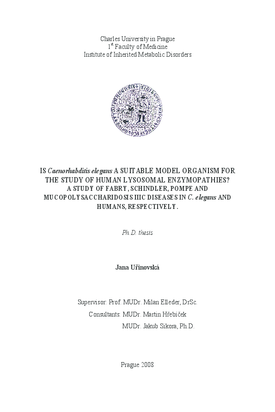Is Ceanorhabditis Elegans a Suitable Model Organism for the Study of Human Lysosomal Enzymopathies? A Study of Fabry, Schindler, Pompe and Mucopolysaccharidosis IIIC Diseases in C. Elegans and Humans, Respectively
Ceanorhabditis Elegans vhodným modelovým organismem pro studium lysosomálních střádacích onemocnění? Studie Fabryho, Schindlerovi, Pompeho choroby a mukopolysacharidozi IIIC v C. elegans a člověku, respektive
dizertační práce (OBHÁJENO)

Zobrazit/
Trvalý odkaz
http://hdl.handle.net/20.500.11956/19501Identifikátory
SIS: 112669
Katalog UK: 990011193860106986
Kolekce
- Kvalifikační práce [4870]
Autor
Vedoucí práce
Oponent práce
Smetana, Karel
Raška, Ivan
Fakulta / součást
1. lékařská fakulta
Obor
-
Katedra / ústav / klinika
Ústav dědičných metabolických poruch 1.LF a VFN v Praze
Datum obhajoby
11. 12. 2008
Nakladatel
Univerzita Karlova, 1. lékařská fakultaJazyk
Angličtina
Známka
Prospěl/a
The Ph.D. thesis is focused on lysosomal storage disorders (LSD) with impaired lysosomal metabolism of glycans, namely on Fabry, Schindler, Pompe diseases and muccopolysaccharidosis (MPS) type IIIC. We hypothesized that the worm, which has active glycan metabolism, will have orthologs corresponding to human enzymes deficient in the above disorders and could be a suitable model for study of cellular pathology of these LSDs. The protein families of glycosidases which are deficient in the first three disorders are well characterised while the protein deficient in MPS IIIC was unknown and its enzymatic action was only partially characterized. The gene deficient in MPS IIIC was recently identified in our lab (publication 2) and, as is shown below, it belongs to the lysosomal proteins that have no apparent ortholog in the worm. The main task of the thesis was to find and characterize the C. elegans orthologs of human α-galactosidase (α-GAL), α-N-acetylgalactosaminidase (α-NAGA), acid α- glucosidase (GAA) and heparin acetyl-coenzyme A:α-glucosaminide N-acetyltransferase (HGSNAT) whose deficit leads to Fabry, Schindler, Pompe and MPS IIIC diseases, respectively, and to study their biological functions in C. elegans by RNA-mediated interference (RNAi). Additional aims were to perform basic bioinformatic analysis and...
